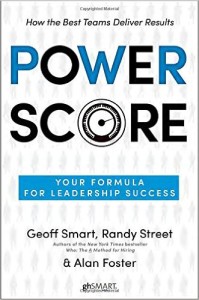 I am intrigued by a new book, “Power Score“, by Geoff Smart, Randy Street and Alan Foster that was recently reviewed on Leading Blog here Are You Running at Full Power?. It explores the key factors that determine performance. Based upon research with other 15,000 careers and 9 million data points, in every major industry, it turns out only about 10% of us are running at full power!
I am intrigued by a new book, “Power Score“, by Geoff Smart, Randy Street and Alan Foster that was recently reviewed on Leading Blog here Are You Running at Full Power?. It explores the key factors that determine performance. Based upon research with other 15,000 careers and 9 million data points, in every major industry, it turns out only about 10% of us are running at full power!
The book focuses on what the authors call your “Power Score“. They even provide a formula to identify your personal “Power Score” that I find simple and easy to remember.
The Power Score Formula
Power Score = (P x W x R)
The elements of this formula are based on three questions you should be asking yourself and your team:
1. Do we have the right (P)riorities? (Only 24 percent of leaders do).
2. Do we have the right (W)ho? (Only 14 percent of leaders do.)
3. Do we have the right (R)elationships? (Only 47 percent of leaders do).
“The key to great leadership is to have the right priorities, the right people on your team, and the right relationships that achieve results.” (Power Score: Your Formula for Leadership Success).
According to Leading Blog’s review:
“Interestingly, their research found that where most leaders were weakest related to the who and then priorities. The relationship factor was the strongest factor by far.”
Let’s look at how the authors define these areas in a little more depth.
P – Priorities
Determined by how well the priorities are in line with the mission. Are they clear? Are they focused? Will they get us want we need? Priorities that do not have a strong connection with the mission will result in a low P score. The authors show this to be the second weakest area for most leaders. I have found many of my clients understand the importance of setting priorities, however when it comes to choosing them, they do not always select the best ones. Sometimes they are not clear enough; sometimes the are vague and unmeasurable; and sometimes they are just not in sync with the desired outcome. Understanding which priorities to set and how well they connect with the mision is critical to success.
W- Who
The W scores our ability to match our team members to the priorities. Have we looked at our team over all and identified its strengths and weaknesses? Can the team accomplish priorities? How well have we matched each team member to a specific priority? How well do we develop our people, setting them for success? As the authors have stated, and as I’ve seen in many of my coaching clients, this tends to be the area where most leaders are weakest. The ability to identify personality traits, working styles and motivators within people is rarely an innate skill, which may be why it’s such a weak area among leaders.
R – Relationships
The all-critical R score focuses on Communication, Commitment and Challenge. How well is communication coordinated within our team? Does the team communicate with the right people at the right time? Is our team committed to the mission? Have we been able to get them emotionally invested in their work? Finally, have we challenged the team? Are they working together to accomplish something bigger than themselves? These elements are key to creating relationships that achieve significant results. I have found it’s rare to see a top leader who doesn’t understand the importance of relationships. In many cases it’s how they became leaders in the first place. But don’t ignore this part of the Power Score. In my dealings with my leadership clients, I have yet to see one that hasn’t benefited from developing this area even more.
I have found these three principles to be critical in helping corporate and organizational teams develop effective engagement that produces results. Through my unique Step Up Leader facilitated process, I have helped many organizations and their leaders align with the all-important P, W and R Factors, Helping them drive up their Power Score.
Power, with the right mindset, can be a beautiful thing.


